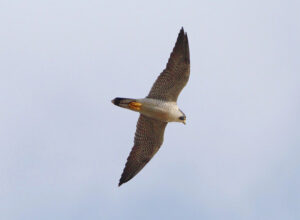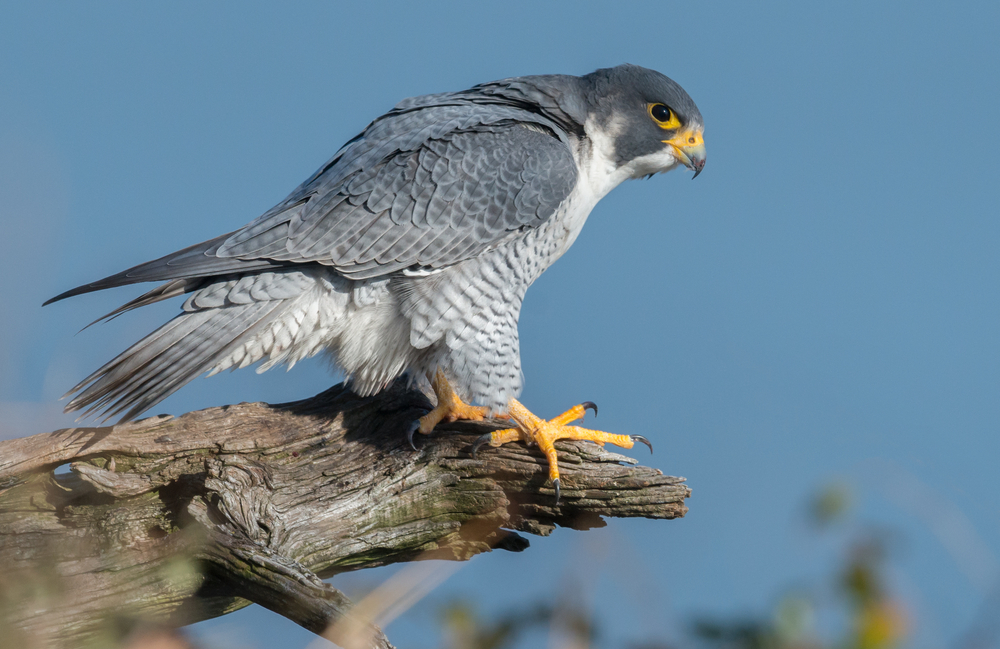Peregrine Falcon, Falco peregrinus
Bill Rowe
We’ve covered several cosmopolitan birds, like the Barn Swallow and the Mallard, and the Peregrine Falcon is right up there with those two—not as numerous or commonplace, but just as widespread, found on every continent except (as usual) Antarctica. It is famous as the prototypical falcon; as a prized species for the sport of falconry; and as, reputedly, the fastest bird in the world, at least when it is hunting by “stooping” on prey. At such times, dropping at a slant or even straight down with wings tucked, its speed has been estimated to reach 200 mph or more. It will also hunt by rapid, level pursuit, and it can either knock its prey to the ground (followed by capture there) or seize it in flight. Typical prey is other birds, especially pigeons and doves, but also shorebirds, ducks, or just about anything else; and at times it will go after small mammals or insects. Its conservation success story goes like this: For two decades after World War II, Peregrines declined alarmingly, to the point where there were no nesting birds at all left in the eastern U.S. and lower numbers than formerly in the west, though arctic Canada still had a good population. This pattern suggests a correlation with agriculture, and sure enough, research eventually proved that the insecticide DDT was a major culprit, not only with Peregrines but with other raptors as well; it caused thinning of their eggshells and thus failure of reproduction. Once DDT was banned in the U.S. (1972) and began to dissipate in the environment—a slow process—the raptors affected all began to stabilize and then bounce back. Humans helped Peregrines at this point by introducing them into artificial nest boxes, including on ledges of tall city buildings where they hunt pigeons and raise young successfully. When the Endangered Species Act was passed, in 1973, the Peregrine was immediately put on the list; it was then de-listed just 26 years later as a result of a truly remarkable recovery.
IDENTIFICATION: The Peregrine is a medium-sized raptor, about the length of a crow or a Cooper’s Hawk. In the air, it is obviously a falcon, moving fast (or occasionally soaring) on long wings with sharp-pointed tips; at rest, its wings reach the tail-tip, and its face pattern can be seen better (a broad dark “sideburn” or “mustache”). Adults are blue-gray above and whitish below, barred with dark gray (see above); juveniles are brown with heavy lengthwise streaking underneath (see below, left). The only real confusion is with other falcons: briefly, the Merlin is smaller with a much less prominent mustache mark; the rare, same-size Prairie Falcon is paler brown with blackish patches in the “wingpit”; and the extremely rare Gyrfalcon is bigger and would require special care to identify.
ST. LOUIS STATUS: A year-round nesting resident at a few favored sites like the Riverlands area and downtown St. Louis, and also an uncommon migrant, spring and fall, as the arctic-breeding birds pass through.
Learn more and listen to the calls of Peregrine Falcons here.


Juvenile: note heavy streaking underneath
Photo Credit: Al Smith
Adult showing typical falcon shape
Photo Credit: Al Smith




